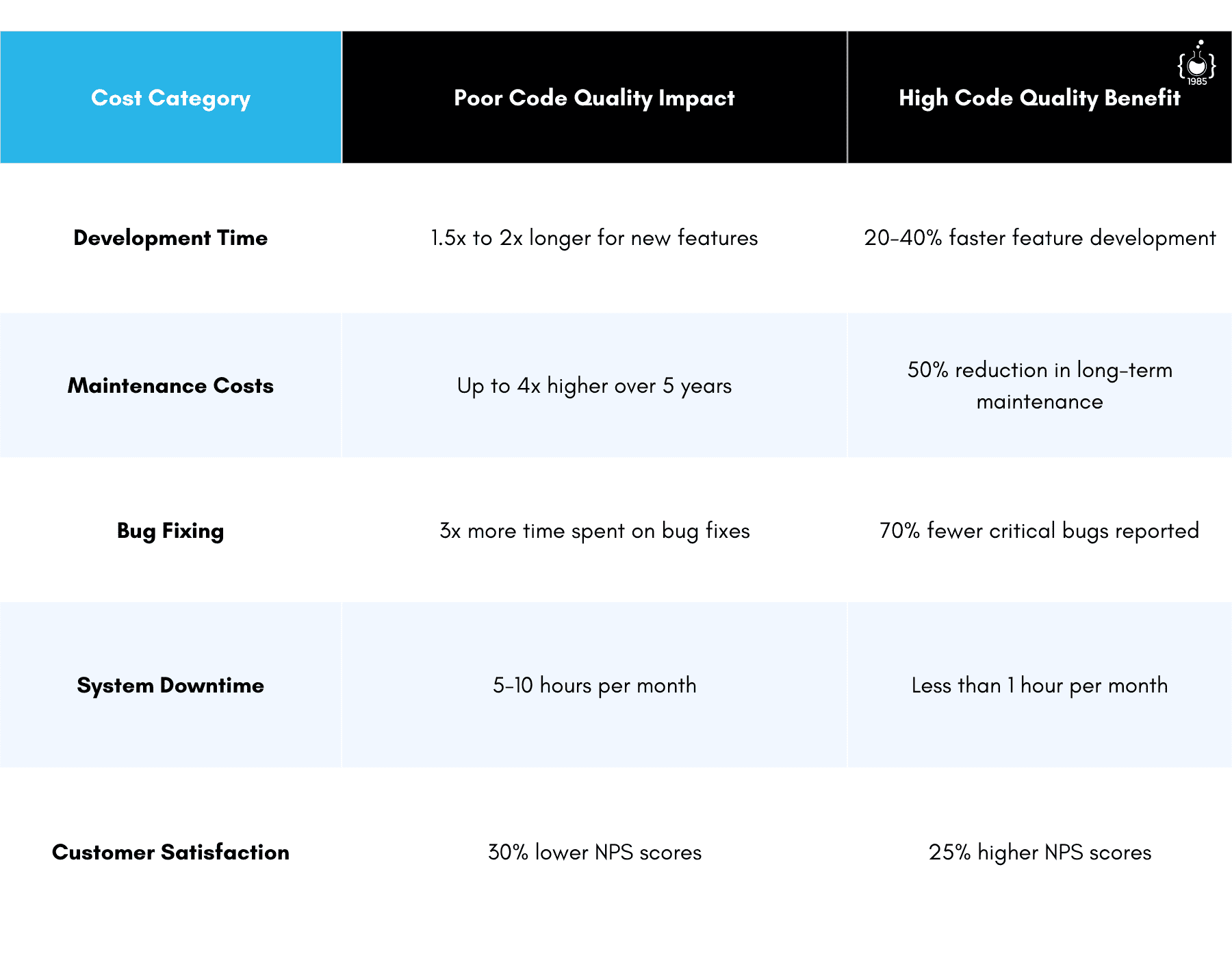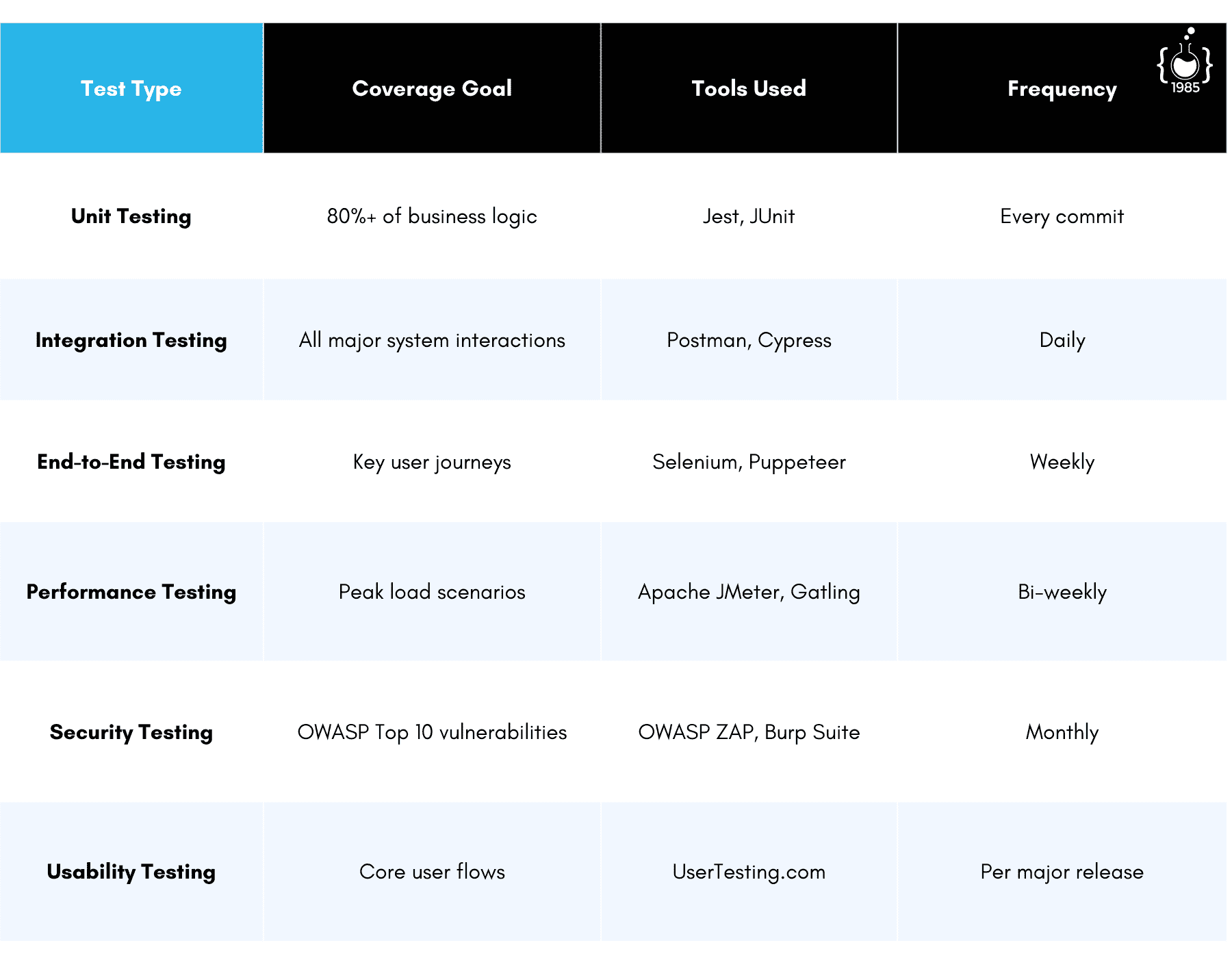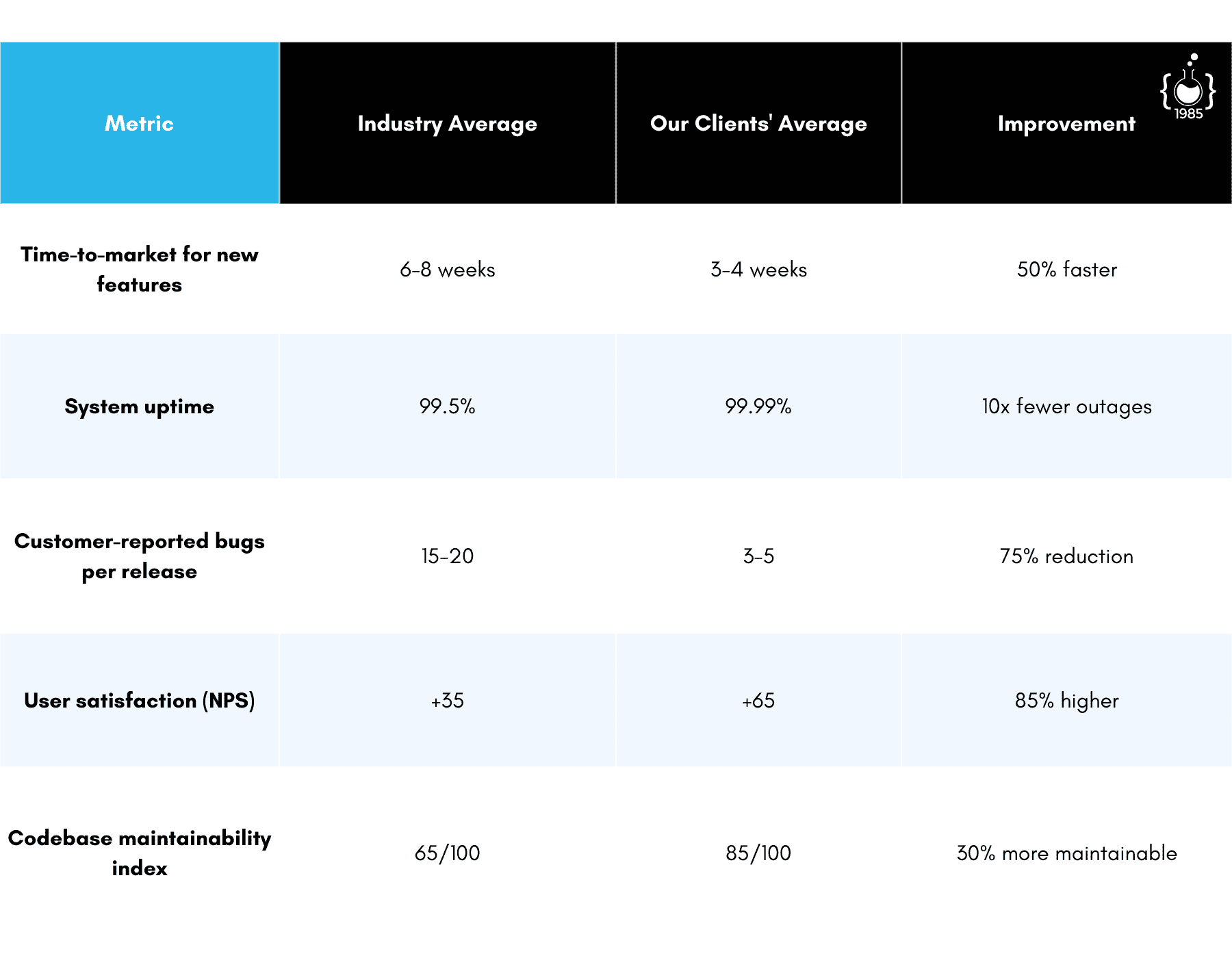How We Ensure the Quality of Code in Outsourced Development
Outsourcing your software development? Here's how we ensure your code is top-shelf, not bargain-bin.

Code quality isn't just a technical issue—it's the lifeblood of any successful software project. And when you're in the business of outsourced development like we are at 1985, it's not just important. It's everything.
Let me take you back to a crisp autumn morning in 2018. I was sitting across from the CTO of a promising fintech startup, his face a mask of frustration and barely contained panic. They'd outsourced their core banking platform to a development shop that promised the moon and stars at bargain-basement prices. Now, barely a year later, they were drowning in a sea of bugs, missed deadlines, and ballooning costs. Their dream of disrupting the banking industry was crumbling, all because they'd cut corners on code quality.
That meeting changed everything for me. It crystallized my mission: to build an outsourcing company that put code quality at the forefront of everything we do. Not as an afterthought or a nice-to-have, but as our north star.
In this article, I'm going to pull back the curtain and show you exactly how we do it. No fluff, no corporate-speak—just battle-tested strategies and tactics we use every day to ensure our clients get code that doesn't just work, but excels. Code that stands the test of time and sets them up for long-term success.

The Critical Importance of Code Quality
Before we jump into our methods, let's underscore why code quality is so crucial in outsourced development.
Companies can't afford to cut corners on code quality. We've seen firsthand the consequences of poor code quality in various projects we've been brought in to rescue. One particularly memorable case involved a mid-sized e-commerce company that had previously worked with a less diligent outsourcing partner.

This company approached us with what seemed like a simple request: add a few new features to their existing platform. However, as we began to dig into their codebase, we uncovered a tangled web of poorly structured, undocumented code. Simple changes were taking days instead of hours. The system was riddled with bugs, and performance issues were causing frequent outages during peak shopping times.

The cost to the company was significant:
- Lost sales due to website downtime
- Delayed launch of new features, allowing competitors to gain market share
- Increased customer support costs dealing with bugs and errors
- Ballooning development costs as more and more resources were poured into maintaining the system
In the end, the company had to make the difficult decision to rebuild large portions of their platform from scratch, costing them hundreds of thousands of dollars and several months of lost time.
This scenario is more common than many realize. According to a study by CISQ, the cost of poor software quality in the US alone was $2.08 trillion in 2020. This includes costs from software failures, unsuccessful IT projects, and technical debt.
As an outsourcing partner, we see it as our responsibility to prevent such scenarios. High-quality code is not just about clean syntax or clever algorithms. It's about creating a stable, maintainable, and scalable foundation that supports our clients' business goals and future growth.

Our Approach to Ensuring Code Quality
At 1985, we've developed a comprehensive approach to code quality that spans the entire development lifecycle. Here's an in-depth look at our key strategies:

1. Establishing Clear Quality Standards from the Outset
One of the first steps in any new project is to align with our clients on what constitutes high-quality code. This goes beyond just agreeing on a coding style guide. We engage in detailed discussions about:
- Architecture and design principles
- Performance expectations
- Security requirements
- Scalability needs
- Maintainability standards
- Documentation expectations
We then codify these standards into a project-specific “Code Quality Manifesto.” This document serves as a north star for our development team and provides clear, objective criteria against which we can measure our work.
For instance, when working with a fintech startup, our Code Quality Manifesto included specific security standards like “All data must be encrypted at rest and in transit” and performance metrics like “API responses must be delivered within 200ms for 99% of requests."

2. Implementing a Rigorous Code Review Process
Code reviews are a cornerstone of our quality assurance process. However, we've found that the effectiveness of code reviews can vary greatly depending on how they're implemented. Our code review process includes:
- Multi-level reviews: Each piece of code goes through at least two levels of review. First, a peer review by another developer on the team, and then a senior review by a tech lead or architect.
- Automated pre-review checks: Before a human even looks at the code, it goes through automated checks for style, potential bugs, and security vulnerabilities using tools like ESLint, SonarQube, and Snyk.
- Contextual reviews: Reviewers are provided with the full context of the change, including related user stories, architectural decisions, and any relevant discussions.
- Review checklists: We use language and project-specific checklists to ensure all important aspects are covered in each review.
- Collaborative problem-solving: We encourage reviewers to not just point out issues, but to engage in a dialogue about the best solutions.
- Continuous learning: Insights from code reviews are regularly shared with the entire team to elevate everyone's skills.
This process has proven highly effective. In a recent project for a healthcare client, our rigorous review process caught a subtle bug that could have led to incorrect patient data being displayed. The potential consequences of such a bug in a healthcare setting could have been severe.

3. Comprehensive Testing Strategies
We believe that thorough testing is non-negotiable for ensuring code quality. Our testing strategy typically includes:
- Unit Testing: We aim for high test coverage (usually 80%+) of all business logic.
- Integration Testing: To ensure different parts of the system work correctly together.
- End-to-End Testing: Simulating real user scenarios to catch issues that might not be apparent at lower levels.
- Performance Testing: Using tools like Apache JMeter to ensure the system can handle expected loads.
- Security Testing: Both automated scans and manual penetration testing.
- Usability Testing: Often involving real users to ensure the product is intuitive and meets user needs.

We tailor our testing strategy to each project's needs. For example, when working on an IoT project for a smart home company, we implemented additional testing for edge cases in network connectivity and device interactions.

4. Continuous Integration and Continuous Deployment (CI/CD)
We deploy CI/CD pipelines to automate many aspects of our quality assurance process. Our typical CI/CD setup includes:
- Automated building and testing of code on every commit
- Static code analysis to catch potential issues early
- Automated deployment to staging environments for further testing
- Integration with our project management tools to link code changes with user stories and bug reports
This approach allows us to catch and address issues quickly, often before they even make it to a human code review.
In a recent project for a large e-commerce client, our CI/CD pipeline caught a performance regression that would have significantly slowed down their checkout process. The issue was caught and fixed within hours, long before it could have affected the live system.

5. Comprehensive Documentation
We believe that well-documented code is a key component of code quality. Our documentation standards include:
- Detailed inline comments for complex logic
- README files for each major component or module
- Comprehensive API documentation
- Architecture decision records (ADRs) to capture the context behind significant technical choices
- User guides and operational runbooks for complex systems
We use tools like Swagger for API documentation and MkDocs for creating searchable, version-controlled documentation sites.
For a recent project with a financial services client, we created a comprehensive documentation suite that not only aided in development but also significantly simplified the process of obtaining regulatory approval for their system.
6. Regular Code Quality Audits
In addition to ongoing quality assurance measures, we conduct regular code quality audits. These audits involve:
- Running advanced static analysis tools to identify potential issues
- Reviewing architectural decisions in light of evolving project requirements
- Assessing the current state of technical debt and creating plans to address it
- Evaluating the effectiveness of our current quality assurance processes
These audits often uncover opportunities for improvement that aren't apparent in day-to-day development. For instance, an audit for a long-term client revealed that certain parts of their codebase were becoming overly complex. We were able to propose and implement a refactoring plan that significantly improved the maintainability of the system.

The Business Impact of Our Quality-First Approach
Our unwavering commitment to code quality has had significant positive impacts for our clients:
- Reduced Total Cost of Ownership: While our initial development costs may sometimes be higher than less quality-focused competitors, our clients typically see much lower maintenance and enhancement costs over time.
- Faster Time-to-Market for New Features: With a clean, well-structured codebase, we're able to implement new features more quickly and with fewer bugs.
- Improved System Reliability: Our clients report fewer critical bugs and system outages, leading to higher user satisfaction and reduced support costs.
- Better Scalability: Our focus on performance and scalability from the outset means our clients' systems can grow with their business without requiring frequent, disruptive overhauls.
- Easier Knowledge Transfer: Our comprehensive documentation and clean code practices make it easier for clients to onboard new developers or bring development in-house if they choose to do so.
One of our startup clients recently secured a new round of funding, with investors specifically citing the quality and scalability of their technology platform (which we had developed) as a key factor in their decision to invest.
Closing Thoughts
Code quality can make the difference between a successful, scalable product and a costly liability. At 1985, we've made it our mission to deliver the former. By implementing rigorous quality assurance processes, using advanced tools and technologies, and fostering a culture of quality among our development teams, we ensure that our clients receive code that not only meets their current needs but positions them for future success.
Whether you're a startup founder looking to build your MVP or a corporate executive seeking to accelerate your digital transformation, remember that the quality of your code is an investment in your future. Choose a development partner who understands this and has a proven track record of delivering high-quality code. Your future self will thank you.



